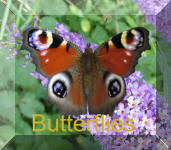Clouded Yellow ( Colias hyale )
The Clouded Yellow is one of the truly migratory European butterflies and a regular visitor to Britain and Ireland. Although some of these golden-yellow butterflies are seen every year, the species is famous for occasional mass immigrations and subsequent breeding, which are fondly and long remembered as 'Clouded Yellow Years'. A small proportion of females are pale yellow (form helice), which can be confused with the rarer Pale and Berger's Clouded Yellows.
Identification
Medium sized; wingspan 55-65 mm.
Both sexes upper surfaces of the forewings are a yellow to dull orange colour with a broad dark grey-brown outer margin. There is a black spot in the centre of the forewings just behind the leading edge and a number of amorphous small yellow blotches in the dark outer margin. The hind wings are similarly coloured on their upper surfaces but a rather larger orange spot replaces the black spot of the forewing. However, it is extremely rare to catch even a glimpse of the upper wing surfaces whilst the butterfly is at rest since it invariably closes its wings. The undersides of the wings are a paler greenish yellow with a row of rather vague darker spots extending down inside outer the outer wing margins. Most noticeably, there are two white spots, of which the upper is very small, in the centre of the hind wings surrounded by a double brown halo. Only the larger of the two white spots is obvious unless viewed from very close quarters.
A pale variety of the species, helice, which is peculiar to females only, is not uncommon and is easily confusable with Bergers Clouded Yellow, Colias australis.





Behaviour and life history
The Clouded Yellow is a migratory species which, whilst it can breed in this country, cannot overwinter. The migrants are the offspring of Mediterranean winter broods and the numbers reaching this country various enormously from year to year. Being a migratory species few stay in one place for long unless they make a temporary stop around potential breeding grounds. Even within breeding territories, they seem to be continually on the wing only resting up and feeding occasionally. Early migrants lay their eggs in June with the caterpillars emerging two to three weeks later and pupating in July. Second generation adults emerge during August and the eggs they lay complete their life cycle and emerge as adults in October. The caterpillars feed on clovers, Trifolium spp, and birds-foot trefoils, Lotus spp and Meddicks, Medicago spp.
Where to look for it
Clouded yellows can be seen everywhere and anywhere during their migration and present quite a spectacle as they arrive over the coast after their flight across the English Channel.
Distribution and status
In good migration years it can be very abundant whilst in poor years you may be lucky to see only one or two.
Similar species
The yellow colouration makes this species only confusable with the Brimstone, Gonepteryx rhamni, but the angular wings of the latter should prove conclusive.Pale Clouded much rarer .

